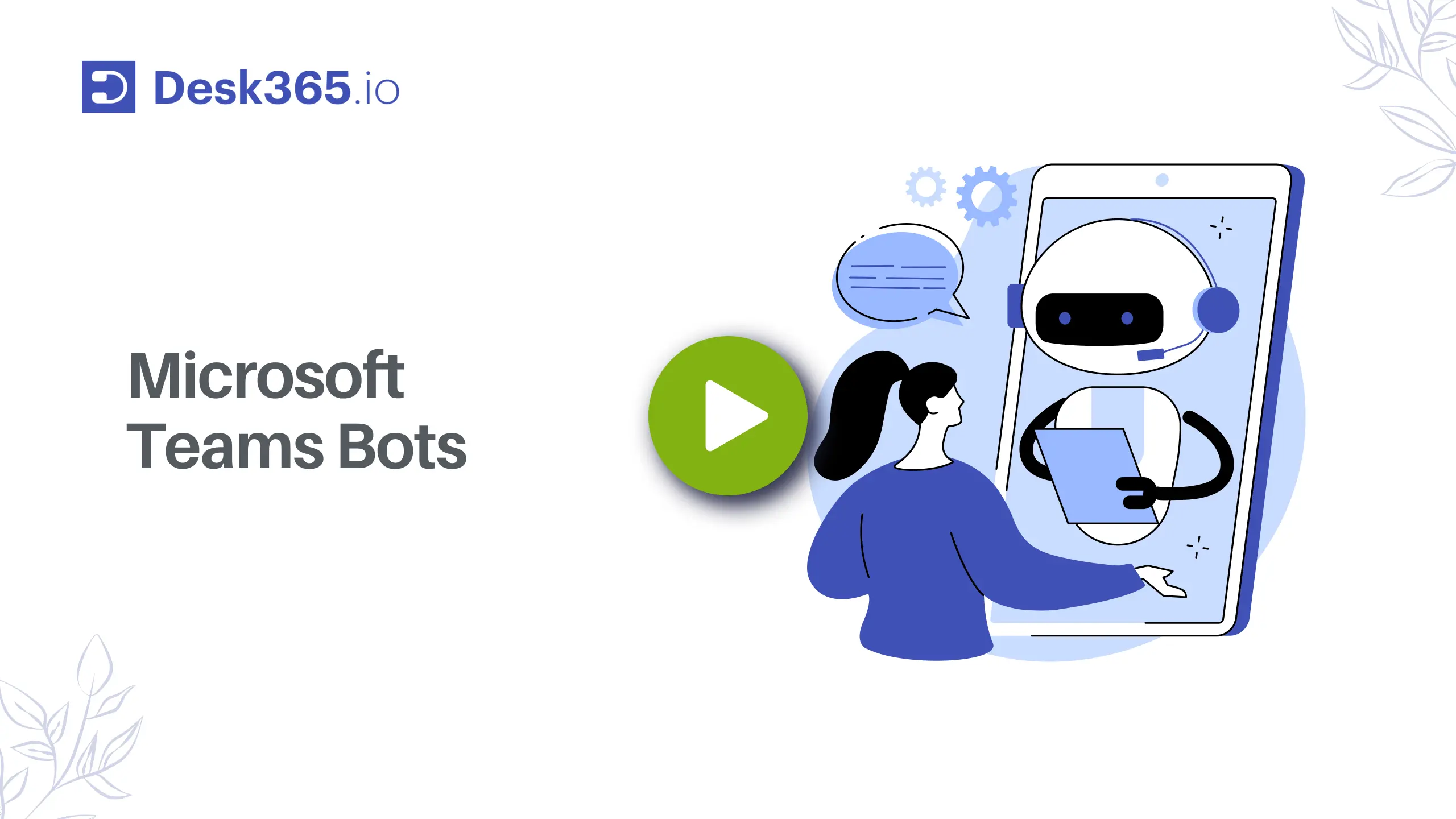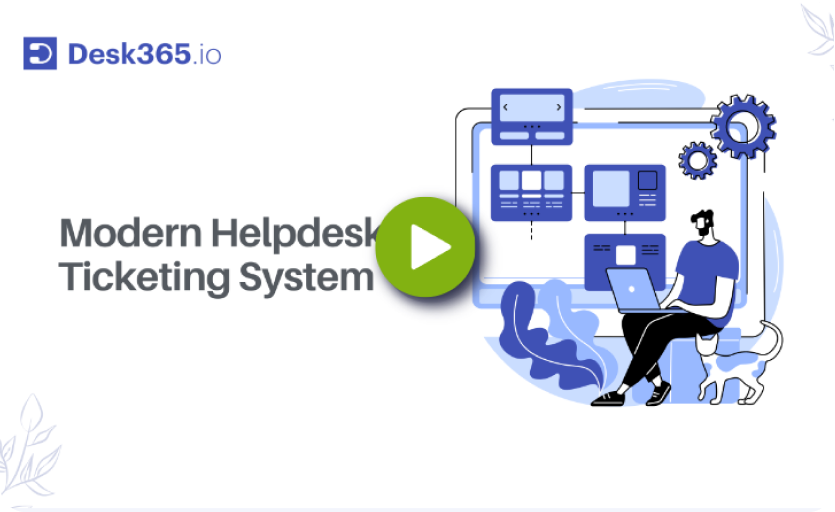That’s where we come in! In this blog, we’re not just going to skim the surface or throw around fancy tech jargon. We’ll dive into real user reviews, compare the features that matter, and talk about what you actually need from your helpdesk software (because let’s face it, not every team needs all the bells and whistles).
Whether you’re just starting out and need something simple and budget-friendly or you’re scaling up and need a powerhouse solution, I’ve got you covered. By the end of this, you’ll know exactly what to look for and how to pick a helpdesk tool that makes your life easier—without breaking the bank or giving you a headache.
Let’s figure this out together!
How do you choose helpdesk software?
Choosing the right helpdesk software is a big step toward improving customer support and making your operations more efficient. Here’s a straightforward guide to help you pick the best option for your business:
🔹 What’s the primary purpose of the help desk software?
Is it for handling customer queries, managing internal IT requests, or both?
🔹 Who will be using it?
How many team members need access, and are they tech-savvy or beginners?
🔹 What are your must-have features?
Think about essentials like ticketing, automation, reporting, or knowledge bases.
🔹 Do you have any unique requirements?
For example, do you need multilingual support, advanced workflows, or custom branding?
🔹 Which communication channels does it need to cover?
Should it handle email, live chat, social media, or phone support?
🔹 How much are you willing to spend?
What’s your budget range, and is it flexible for scaling up?
🔹 Where do you want your data stored?
Would you prefer a cloud-based tool for easy access, an on-premise setup for more control, or a mix of both?
Try free helpdesk software
When it comes to choosing the right helpdesk software, starting with a free plan or trial can be a game-changer. It’s the perfect way to dip your toes in and see how the tool aligns with your business needs without committing to a subscription upfront. Think of it as a no-strings-attached test drive—you can explore the features, understand the interface, and even evaluate how well it integrates into your existing workflows.
This approach not only minimizes risk but also ensures you’re investing in a solution that genuinely fits your requirements.
1. Desk365
Desk365 offers a free plan tailored for hobby projects and testing purposes. This plan supports up to 3 agents and allows for 50 tickets per month includes all features.
2. Zoho Desk
Zoho Desk’s free plan accommodates up to 3 agents and provides multi-channel support, including email, web, and social media integration. It also features live chat and a private knowledge base for agents.
3. Jira Service Desk
Jira’s free plan is designed for small teams, supporting up to 3 agents with unlimited customers. It includes features like queues, SLA management, and automation capabilities.
4. Freshdesk
Freshdesk’s free plan includes email ticketing, social media integration, and a knowledge base. It supports unlimited agents and is suitable for small to medium-sized businesses.
5. Help Scout
Help Scout offers a free plan for small teams. It includes email ticketing, a shared inbox, and basic reporting features to help you stay organized and deliver excellent customer support.
The best helpdesk software: Pricing and ratings comparison chart
This comparison chart provides an overview of key details for my top help desk software picks. It allows you to compare pricing, rating and free trial options, side-by-side, making it easier to identify the best help desk software for your business and budget requirements.
Software
Pricing
Capterra Overall Ratings
Desk365
Starts $12 /agent /month
4.9
Zendesk
Starts $55 /agent/month
4.4
Zoho Desk
Starts $14 /agent /month
4.5
Freshdesk
Starts $15 /agent /month
4.5
Help Scout
Starts $20 /agent /month
4.7
Jira Service Desk
Starts $20 /agent /month
4.5
Spiceworks
Free
4.4
HappyFox
Starts $26 /agent /month
4.6
LiveAgent
Starts $15 /agent /month
4.7
Front
Starts $19 /agent /month
4.6
Best help desk platforms backed by user reviews
I’ve rounded up my top 10 help desk software picks to make it easier for you to find the right one. For each, I’ve included a quick summary, why it made the list, key features, pros and cons, and the best use cases to help you figure out what works for your business.
On top of that, I’ve added 16 more options at the end, covering a variety of needs, so you’ll have plenty of choices to find the perfect match for your team.
- Desk365
- Zendesk
- Zoho Desk
- Freshdesk
- Help Scout
- Jira Service desk
- Spiceworks
- HappyFox
- LiveAgent
- Front

1. Desk365
Seamless integration with Microsoft Teams, enabling ticket creation and management directly within Teams.
Here’s why Desk365 earned its spot on the list:
I promise I’m not playing favorites, but Desk365 genuinely deserves its spot on this list.
Desk365 makes a strong case for being an excellent help desk solution, especially for small to mid-sized businesses. Its user-friendly design, affordable pricing, and essential features like a robust ticketing system, automation, and reporting capabilities make it practical and approachable for teams without a steep learning curve.
One standout feature is its seamless integration with Microsoft Teams, enabling users to create, assign, and manage tickets directly within the app many teams already use daily. This convenience can boost productivity by keeping everything in one place.
While no tool is perfect, Desk365 delivers great value for the price and focuses on what truly matters to most businesses. Whether you’re new to help desk software or need an efficient yet straightforward solution.
Desk365 features:
- Cloud-based ticketing system
Easily manage, track, and resolve customer inquiries with an intuitive and flexible cloud-based ticketing platform. - Automation tools
Streamline repetitive tasks like ticket assignments, escalations, and notifications, allowing your team to focus on resolving customer issues. - AI-powered drafts
Leverage AI to generate response drafts for tickets, helping agents save time and respond more efficiently. - Customizable workflows
Design workflows tailored to your team’s specific needs, ensuring a smooth and consistent ticket resolution process. - Collaboration features
Enable seamless teamwork with tools to share tickets, add internal notes, and coordinate responses across teams. - Microsoft Teams integration
Create, assign, and manage tickets directly within Microsoft Teams, keeping all customer interactions in one place. - Knowledge base creation
Build a self-service portal for customers with FAQs, how-to guides, and helpful resources, reducing the need for repetitive inquiries. - Multi-channel support
Handle customer interactions from email, web widget, Microsoft Teams, phone, web form, and other platforms through a unified interface. - Real-time notifications
Receive instant alerts for new tickets, status updates, and critical changes, keeping your team informed. - Reporting and insights
Access powerful analytics to monitor team performance, identify trends, and improve customer satisfaction.
Why should you consider Desk365?
This review highlights that Desk365 stands out for its performance, support, and ease of use, making it a reliable help desk solution for teams of all sizes. The platform is incredibly fast, ranking as one of the quickest help desk systems many users have worked with, ensuring efficiency and smooth operations even during high workloads.
Pros - The helpdesk system everyone should know about
Performance, Support, Easy-to-use. The Performance is incredible – one of the fastest Helpdesk systems I have ever worked with. The Support is just amazing. Any inquiries will be answered quickly and professionally. Easy-to-use: almost no one, from our ~100 employees, needed any training. It’s self-explanatory.
Things to watch out for
This feedback highlights one of Desk365’s areas for improvement: notifications and templates. The user mentions that these features could be enhanced to match the quality they experienced with their previous help desk solution, where templates and notifications were a strong point.
However, the comment also reflects optimism and trust in Desk365’s commitment to progress. The user acknowledges that Desk365 has already made significant advancements and notes that they are actively working to improve these features.
Cons
I think the notifications and templates can be greatly improved. This was a strong suite in our last helpdesk and was the better part of it. Desk365 has come along way and I know they are working on these features.
Desk365 pricing
Desk365 offers a comprehensive set of features starting at $12. It’s an affordable and effective solution that can meet your ticketing system needs without breaking the bank.
Omni-Channel
- Microsoft Teams Ticketing
- Email Ticketing
- Customer Support Portal
- Web Form/Web Widget
- Unified Inbox
Process Automation
- Automation Rules
- Custom Response Templates
- Canned Responses
- Tasks/To-do Lists
- Time Tracking
- SLA Management & Business Hours
- SLA Reminders & Escalations
- Multiple SLAs
- SLAs in Automations
Ticket Management
- Custom Ticket Views
- Customer Management
- Responsive Mobile Web Apps
- Multiple Emails
- Multiple Groups/Departments
- Draft with AI
- Collision Detection
- Closure Rules
- Knowledge Base
Data & Analytics
- Customer Surveys & Reports
- Ticket Trend Reports
- Productivity/SLA Reports
- Export Data
- Import Data
Customization
- Custom Email Servers
- Custom Ticket Fields
- Custom Forms
- Custom Roles
- Custom Reports & Graphs
- Remove Desk365 Branding
Integrations
- Entra ID Single Sign-on
- API Access
- Web-hooks
- Power Automate Connector
- Microsoft 365 Copilot Plugin
Support
- Free Setup and Installation
- Priority Support
Switch to a better Ticketing System now!

2. Zendesk
Comprehensive multi-channel support with extensive customization and integration options.
Here’s why Zendesk earned its spot on the list:
It’s one of the most comprehensive and versatile help desk platforms available, designed to handle businesses of all sizes. Zendesk excels in providing seamless multi-channel support, letting you manage customer interactions across email, chat, phone, and social media from one unified interface.
Its customization options and robust integrations with countless tools make it a top choice for businesses that need a tailored solution. Plus, with powerful reporting features, automation capabilities, and an intuitive self-service portal, it’s well-suited for teams looking to enhance efficiency and customer satisfaction. While it’s on the pricier side, the depth of functionality justifies the cost for businesses that prioritize top-tier support solutions.
Zendesk features:
- Multi-channel support
Manage customer interactions across email, chat, phone, social media, and more from a single platform. - Robust ticketing system
Streamline customer inquiries with an intuitive ticketing system for efficient case management. - Automation and AI
Automate repetitive tasks, manage workflows, and use AI-powered chatbots to handle common queries. - Customizable dashboards
Tailor the interface to match your team’s workflows and preferences. - Knowledge base
Create self-service portals for customers with FAQs and helpful articles. - Reporting and analytics
Gain insights into team performance, customer satisfaction, and support trends with in-depth reporting tools. - Integration capabilities
Connect with popular apps and services like Salesforce, Slack, and Google Workspace. - Omnichannel support
Seamlessly switch between communication channels without losing context. - Scalable plans
Designed to cater to businesses of all sizes, from startups to enterprises. - Self-service tools
Empower customers to resolve issues on their own with accessible resources.
Why should you consider it?
This feedback says, Zendesk’s ticketing system is a robust solution for managing customer inquiries from various channels like email, phone, chat, and social media. It centralizes communication, ensuring efficient tracking, prioritization, and resolution of issues. It also offers automation and customizable workflows to streamline ticket management.
Pros
One of the standout features is the ticketing system, which I find very easy to manage. It allows me to effortlessly keep track of requests and address our users’ needs efficiently. Additionally, robust reporting tools provide the ability to generate detailed, customizable reports, which has significantly improved our decision-making process. The platform’s overall simplicity in customization has been another major advantage, enabling us to adapt it perfectly to our workflows.
Things to watch out for
Here’s what users on Reddit are saying about Zendesk,

Detailed breakdown of Zendesk pricing
Zendesk’s pricing structure is designed to meet the needs of businesses of all sizes, from startups to large enterprises. The pricing is divided into five main plans, each packed with specific features to boost your customer support capabilities.
Zendesk offers three main products: Zendesk for Service, Zendesk for Sales, and a three-tier basic plan for support. Each category comes with multiple pricing plans, making it challenging to choose the best fit for your unique business needs. Here’s a breakdown of Zendesk’s offerings:
The variety of plans offered by Zendesk’s customer support software can be overwhelming, especially if you’re a beginner. To simplify, focus on two key aspects: the essential features you need and the number of agents who will use the software. These factors will help guide you through the various options available.
Zendesk offers seven pricing plans: three under the ‘Support’ category and four under ‘Suite.’ Here’s a closer look at what each plan offers:
By focusing on your essential needs and team size, you can more easily navigate Zendesk’s offerings and select the plan that best fits your business.
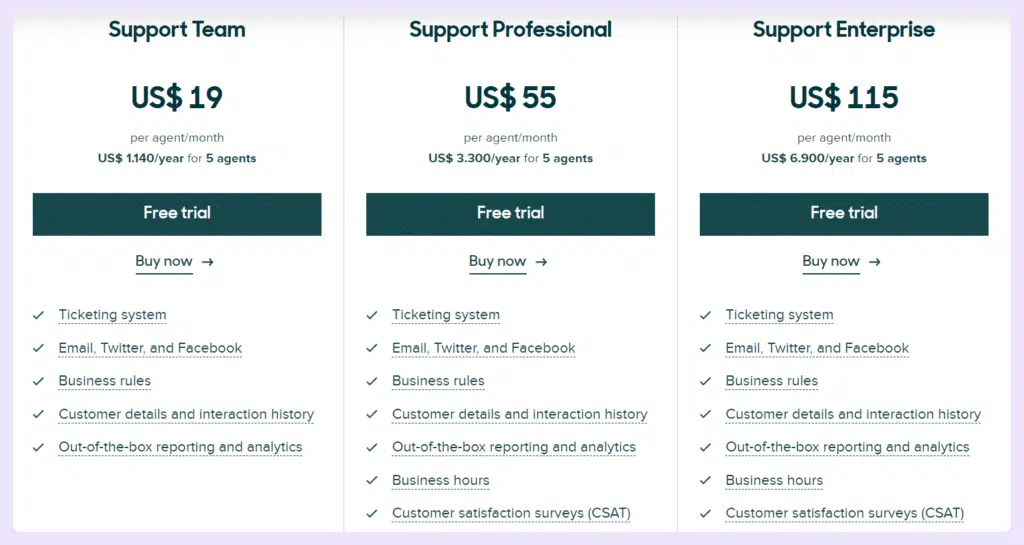
Learn more about Zendesk
- Freshdesk vs. Zendesk: Which is the Best Helpdesk in 2025
- 20 Zendesk Alternatives and Competitors
- 12 Key Zendesk Features in 2024 [+ Pros and Cons Breakdown]
- Zendesk Reviews 2024: The Good, the Bad and the Ugly
- Zendesk Pricing 2024: The Complete Guide
- Zendesk vs Zoho Desk: Which one is Best for your Business in 2024

3. Zoho Desk
Robust workflow automation and AI capabilities for efficient customer support.
Here’s why Zoho Desk earned its spot on the list:
Zoho Desk sets itself apart with its context-aware ticketing system, which provides agents with complete customer histories and contextual information at their fingertips. This ensures faster and more personalized responses.
What’s unique about Zoho Desk is its AI assistant, Zia, which not only analyzes ticket sentiment but also predicts anomalies in ticket trends and recommends solutions before issues escalate.
The platform’s integration within the larger Zoho ecosystem gives businesses access to a suite of tools for CRM, marketing, and more, creating a seamless workflow across departments.
Additionally, its self-service portal allows businesses to empower their customers with resources, FAQs, and community forums, all customizable to match their brand. These innovative features, combined with affordable pricing and scalability, make Zoho Desk a standout choice for businesses seeking intelligent, future-ready customer support.
Zoho Desk features:
- AI-powered assistant (Zia)
Use Zia, Zoho Desk’s AI assistant, to analyze ticket sentiment, predict anomalies, and suggest responses or solutions, helping agents stay proactive and efficient. - Workflow automation
Automate repetitive tasks like ticket routing, escalations, and status updates with custom workflows tailored to your team’s unique needs. - Multi-channel support
Manage customer interactions across email, phone, live chat, social media, and web forms from a single, unified platform. - Knowledge base and self-service portal
Create a branded self-service portal with FAQs, guides, and community forums, empowering customers to find answers on their own. - Integration within the Zoho ecosystem
Seamlessly connect with other Zoho apps like CRM, SalesIQ, and Analytics, or integrate with third-party tools for a streamlined workflow across departments. - Customizable dashboards and reports
Track performance with personalized dashboards and generate in-depth reports to gain insights into trends, agent productivity, and customer satisfaction. - SLA and escalation management
Set service-level agreements and define escalation rules to ensure timely responses and maintain service quality. - Mobile app
Stay connected on the go with Zoho Desk’s mobile app, allowing agents to manage tickets, respond to customers, and access information from anywhere.
Why should you consider Zoho Desk?
The feedback highlights several key advantages of Zoho Desk, particularly in businesses where returning customers are a priority. The user emphasizes how crucial it is to keep customers happy by addressing their issues promptly. Zoho Desk plays a pivotal role in this by enabling fast and efficient customer service. Its seamless integration with other Zoho apps makes it a standout feature, allowing businesses to access customer data easily and deliver personalized experiences without any hassle.
Pros
In my line of business the returning customers is very important and that why is important to keep them happy and respond to their issues as fast as we can. Zoho Desk integrates with ease with other Zoho Apps and make it a great deal, all the data about the customers can be acceded easily. The system is simple and intuitive and all my colleagues use it with ease, even the older non tech ones.
Things to watch out for:
This feedback addresses a couple of limitations with Zoho Desk while acknowledging its value. The user highlights that while the software offers a great return on investment, the upfront fees can be a challenge, particularly for startups or smaller businesses operating on tighter budgets. This suggests that Zoho Desk may not be the most accessible option for those looking for an economical entry point into help desk software.
Cons
Although the program provides a great return on investment, the upfront fees might be prohibitive, especially for startups. One other thing that may be improved with Zoho Desk is the reporting capabilities. I need to export data to external programs to gain a full picture of my customer service performance because the present reporting options are inadequate.
Zoho Desk Pricing
Zoho Desk offers a flexible and tiered pricing system to accommodate the varying needs of businesses, ranging from small startups to large enterprises. The pricing is structured across five main plans, each offering a distinct set of features to enhance customer support operations.
4. Freshdesk
Advanced self-service portals with multilingual knowledge bases and AI-powered chatbots.
Here’s why Freshdesk earned its spot on the list:
Freshdesk is a standout for its advanced self-service capabilities, enabling businesses to set up multilingual knowledge bases and AI-powered chatbots that help customers find answers quickly. This reduces the burden on support teams while keeping customers happy.
What truly sets Freshdesk apart is its intuitive interface, which makes it easy for teams of all sizes to get started without steep learning curves. It’s particularly well-suited for growing businesses, thanks to its scalable plans and flexible pricing.
Another unique strength of Freshdesk is its powerful automation tools that streamline ticket management. From automatically assigning tickets to the right agents to setting up workflows for repetitive tasks, it’s built to save time and improve efficiency.
Freshdesk features:
- AI-powered assistant (Freddy)
Freddy, Freshdesk’s AI assistant, helps agents automate repetitive tasks, suggest responses, and predict ticket trends, ensuring proactive and efficient customer support. - Workflow automation
Automate tasks like ticket routing, escalations, and status updates with tailored workflows to streamline your support process. - Multi-channel support
Manage customer interactions across email, phone, live chat, social media, WhatsApp, and more through a unified platform. - Knowledge base and self-service portal
Create a branded self-service portal with FAQs, guides, and community forums, empowering customers to find answers on their own and reducing ticket volumes. - Customizable dashboards and reports
Generate in-depth reports and customize dashboards to track performance, identify trends, and improve customer satisfaction. - Omnichannel ticketing
Handle conversations seamlessly across multiple channels, ensuring consistent and uninterrupted customer experiences. - Collaboration tools
Enable team collaboration with shared inboxes, internal notes, and the ability to merge or split tickets for better coordination. - Mobile app
Stay connected on the go with Freshdesk’s mobile app, allowing agents to manage tickets, respond to customers, and access data from anywhere. - Third-party integrations
Easily integrate Freshdesk with tools like Slack, Salesforce, and Google Workspace for a smoother workflow across departments.
Why should you consider Freshdesk?
This review highlights how Freshdesk has significantly improved the team’s ability to manage customer support and internal workflows. By using Freshdesk, the team has been able to automate and monitor their process workflows, which reduces manual effort and increases efficiency. This automation ensures that tasks like ticket routing and follow-ups happen seamlessly, allowing the team to focus more on solving customer issues.
Pros
Freshdesk has a wide range of essential services, including live chat, email, phone, and social media support channels. The software is cloud-based and easy to use, with clever automation capabilities that guarantee things are done easily and quickly, resulting in more efficient corporate operations and a better customer experience.
Things to watch out for:
This review expresses frustration with Freshdesk (from Freshworks) over recent changes to its reporting features. The user, who has been a long-time advocate of the platform, is upset that legacy reports—a feature they found easy and simple to use—are being deprecated in favor of analytics tools now placed in the Pro Plan, a higher-tier subscription.
The reviewer also mentions how they don’t want to leave Freshdesk, as they have previously enjoyed the platform, but they are now actively considering alternatives due to this change. This highlights a loss of trust and dissatisfaction with how Freshdesk is handling feature access and pricing, leading them to reconsider their loyalty.
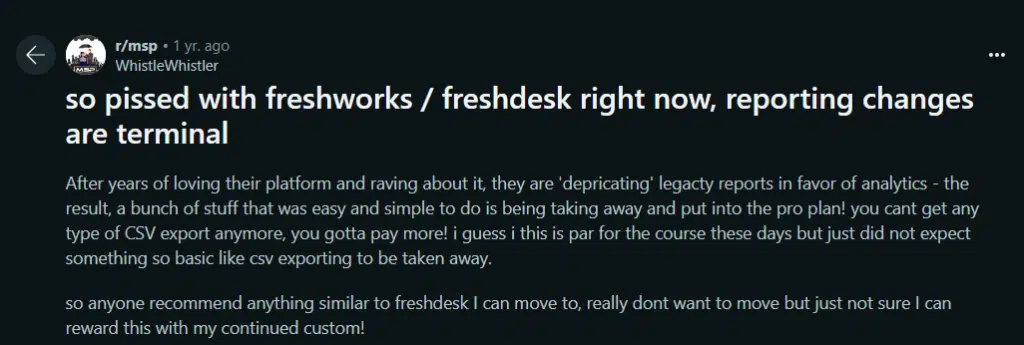
Freshdesk pricing:
Freshdesk offers a structured pricing system tailored to various organizational needs, with multiple plans priced per agent per month. Significant savings are available through annual billing.
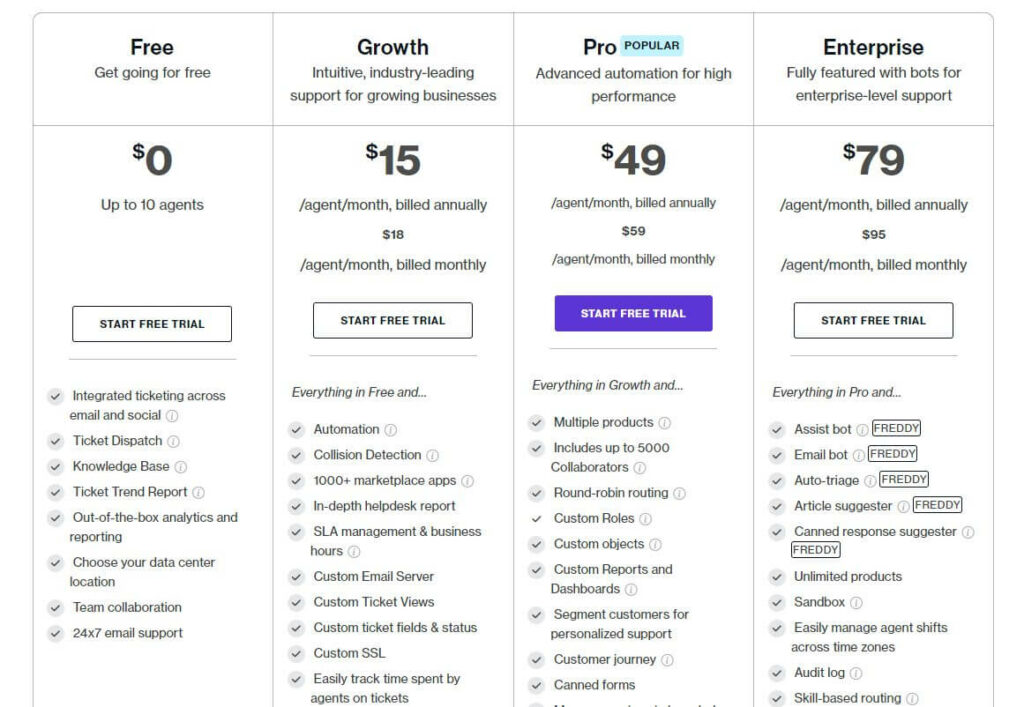

5. Help Scout
Personalized customer interactions with a focus on email-based support and collaboration.
Here’s why Help Scout earned its spot on the list:
Help Scout earned its spot by blending simplicity with powerful functionality, enabling teams to deliver exceptional customer support at scale.
Its standout features include an intuitive shared inbox for seamless collaboration, a robust knowledge base for self-service, and integrations with over 90 tools like Slack and Salesforce.
Help Scout emphasizes personalization and empathy, helping teams build meaningful customer relationships. With transparent pricing, accessible features for businesses of all sizes, and a strong commitment to remote work and social good, Help Scout stands out as a customer support platform with both heart and purpose.
Help Scout features:
- Shared inbox
Collaborate effortlessly with an intuitive shared inbox that ensures every customer query is tracked, prioritized, and resolved without duplication or confusion. - Knowledge base
Empower customers with a branded self-service portal featuring FAQs, guides, and articles, reducing support ticket volume while improving customer satisfaction. - Multi-channel support
Manage customer interactions across email, chat, and web forms in one unified platform, streamlining communication and ensuring consistent service. - Workflow automation
Automate repetitive tasks such as ticket assignment, escalations, and follow-ups with customizable workflows tailored to your team’s needs. - Customer management tools
Access detailed customer profiles and interaction histories directly within the platform to provide personalized, context-rich support. - Reports and analytics
Gain actionable insights with advanced reporting and metrics to monitor trends, measure team performance, and improve customer satisfaction. - Integrations
Seamlessly connect with over 90 tools like Slack, Salesforce, and Shopify to enhance workflows and unify your tech stack. - Beacon live chat
Offer proactive live chat with Help Scout’s Beacon feature, allowing customers to connect instantly with support while browsing your website. - Collision detection
Avoid overlapping responses by alerting team members when someone else is already replying to the same conversation.
Why should you consider Help Scout?
This review highlights a key strength of Help Scout: its simplicity and user-friendliness. The user appreciates that the tool is straightforward, focusing on essential features without overwhelming users with unnecessary complexity. Unlike other customer support tools that might clutter the interface with features rarely used in daily operations, Help Scout keeps things clean and intuitive.
The reviewer notes that the interface is easy on the eyes and well-organized, making it accessible for both new and experienced users. They specifically praise how the inbox is neatly categorized into sections like “unassigned,” “mine,” “drafts,” etc., making navigation simple and efficient. Overall, the review emphasizes that Help Scout’s clean design and functional focus make it an ideal tool for small businesses and support teams looking for an uncomplicated communication solution.
Pros
I like that it’s very simple to use. Nothing too complicated. Like what you need is what you’ll get. Some customer support communication tools/software have a lot of features that we rarely use in our day to day job. And most of them, are just all over the interface which can be too overwhelming for new users. But Help Scout is not one of these tools. It’s just very easy to the eyes and not too overwhelming. You just see your inbox – and the different email categories (unassigned, mine, drafts, etc.). The design is so simple and clean.
Things to watch out for:
Cons
HelpScout primarily focuses on email-based support, which may not meet the needs of organizations that require support across multiple channels like live chat, phone, or social media.
Help Scout pricing
Help Scout offers a structured pricing system tailored to various organizational needs, with a choice between three main plans. Each plan is priced per user per month, with significant savings available through annual billing—up to 20% off.
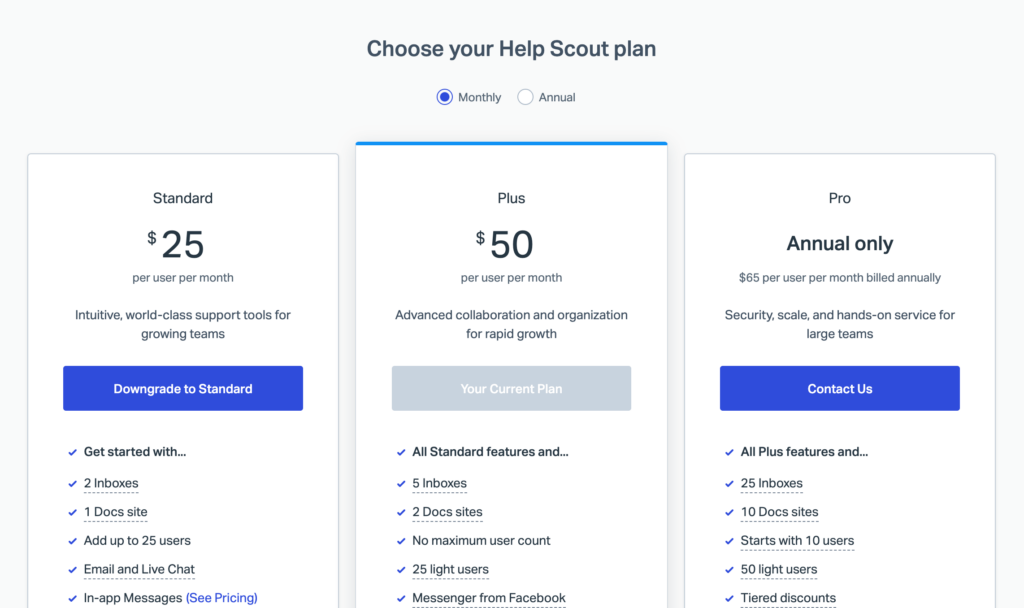

6. Jira Service Desk
Ideal for IT service management with strong integration into development workflows.
Here’s why Jira Service Desk earned its spot on the list:
One of its unique strengths is the ability to leverage Jira’s robust issue-tracking and workflow automation features, ensuring tickets are handled efficiently from creation to resolution. Jira Service Desk’s flexible configuration makes it ideal for ITIL practices, enabling teams to easily manage requests, incidents, problems, and changes while adhering to industry standards.
Jira Service Desk features:
- Shared inbox
Streamline team collaboration with a unified inbox that centralizes requests, ensuring every ticket is tracked, prioritized, and resolved without duplication or delays. - Knowledge base
Empower customers and team members with a self-service portal integrated with Confluence, providing FAQs, articles, and guides to reduce support requests and boost efficiency. - Multi-channel support
Manage and respond to customer issues from email, web forms, or embedded widgets, keeping all communications centralized and accessible. - Workflow automation
Automate repetitive tasks like ticket categorization, assignment, and escalation with Jira’s robust workflow engine, customized to fit your team’s specific needs. - Customer management tools
View detailed customer history and ticket interactions directly in the platform, enabling teams to deliver personalized, efficient support. - Reports and analytics
Gain actionable insights with customizable dashboards and in-depth reporting, helping you track SLA adherence, team performance, and customer satisfaction metrics. - Integrations
Seamlessly integrate with the Atlassian ecosystem, including Jira Software and Confluence, along with third-party tools like Slack, Microsoft Teams, and Zendesk for a unified IT and development experience. - Self-service portal
Offer end-users an intuitive self-service option to submit tickets, track progress, and find solutions through a machine learning-powered knowledge base. - SLAs and escalation management
Define and manage service-level agreements to ensure timely responses and resolutions, with automated escalation rules for high-priority issues.
Why should you consider Jira Service Desk?
This review highlights the positive user experience with Jira Service Management. The user appreciates its ease of use, noting that navigation through projects and boards is straightforward and intuitive. Another key strength mentioned is its seamless integration with other project management tools like Bitbucket and Confluence, which enhances its functionality by enabling efficient tracking of project statuses, issues, and updates.
The tool is also praised for its ease of implementation within existing projects, allowing product managers to monitor tasks and progress effectively.
Why should you consider Desk365?
What I like most about Jira Service Management would be the possibility of being able to use the workflow designer that is included in the tool and being able to design the workflows that I need according to the area of my company. Added to that is the number of add-ons that Atlassian has to be able to integrate third-party software such as SAP or also interesting functions such as Gitlab or OpsGenie.
Things to watch out for:
Cons
Complex setup, expensive for small teams, slower with large data, steep learning curve, and overwhelming customization for non-tech users.
Jira Service Desk pricing
Jira Service Desk offers a structured pricing system designed to meet various organizational needs, with four main plans. Each plan is priced per agent per month, and significant savings are available through annual billing.
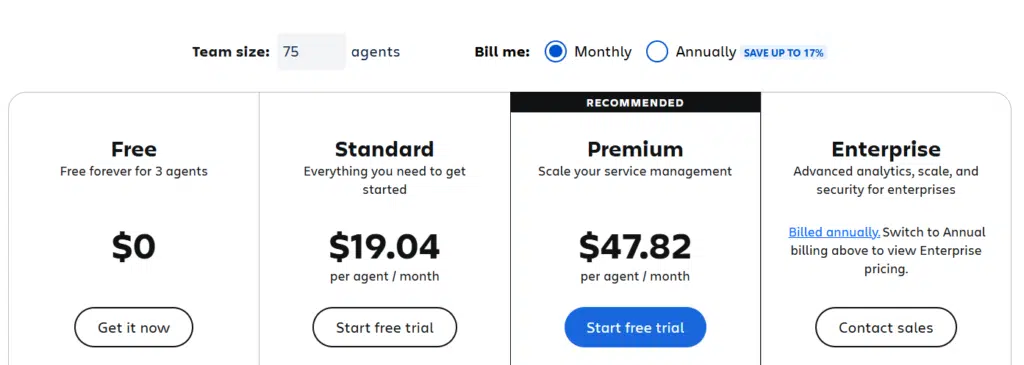
Learn more about Jira Service Desk

7. Spiceworks
Free, ad-supported help desk solution suitable for small to mid-sized businesses.
Here’s why Spiceworks earned its spot on the list:
Here’s why Spiceworks earned its spot on the list: it offers a completely free IT help desk solution, making it a game-changer for small to medium-sized businesses working with limited budgets. Spiceworks stands out for its robust functionality despite being cost-free, providing essential features like ticket management, asset tracking, and network monitoring all in one platform.
One of its unique features is the built-in IT community, where users can connect with millions of IT professionals to exchange advice, troubleshoot issues, and stay updated on industry trends. This collaborative aspect transforms Spiceworks from a tool into a vibrant support ecosystem.
Another reason it shines is its on-premises and cloud-hosted options, giving businesses flexibility to choose the deployment method that best fits their needs. Spiceworks also integrates seamlessly with third-party tools and supports a wide range of customizations, allowing teams to tailor the platform to their workflows.
Spiceworks features:
- Ticket management
Streamline IT support with an intuitive ticketing system that allows teams to track, prioritize, and resolve issues efficiently, ensuring no request is overlooked. - Asset tracking
Monitor and manage your IT assets, including hardware and software, directly within the platform, providing real-time visibility into your organization’s resources. - Network monitoring
Stay proactive by identifying and resolving network issues before they impact users with Spiceworks’ built-in network monitoring tools. - Self-service portal
Enable employees to submit tickets and find answers to common questions through a user-friendly self-service portal, reducing the IT team’s workload. - Community integration
Tap into a vibrant community of IT professionals for troubleshooting advice, best practices, and peer support, all accessible directly from the platform. - Customizable workflows
Adapt Spiceworks to your team’s needs with customizable workflows that automate ticket assignment, prioritization, and escalations. - On-premises and cloud hosting
Choose between on-premises or cloud-based deployment options, offering flexibility to match your organization’s IT infrastructure requirements. - Third-party integrations
Seamlessly connect with tools like Active Directory, Google Workspace, and Office 365 to unify your IT operations and enhance productivity. - Completely free
Access robust IT help desk features without any cost, making Spiceworks an ideal solution for small and medium-sized businesses on a budget.
Why should you consider Spiceworks?
This review highlights both the positives and some challenges of using Spiceworks Cloud Help Desk. The user appreciates that the tool is free, which makes it an attractive option for budget-conscious organizations.
They also value the ability to customize fields, allowing them to tailor the tool to their specific needs. The setup process is described as straightforward and painless, including installing a server and handling upgrades, which suggests ease of implementation.
Pros
I like that Spiceworks is free and that you are able to customize the fields. The setup is pretty painless, setup a server and install, upgrades are the same way. You can use keyboard shortcuts to create tickets, which can make the task of entering tickets pretty fast. They also provide views that allow you to switch between open tickets and my closed tickets, I use that feature a lot.
Things to watch out for:
Cons
Ads and lack of features. But that’s all understandable with free service.
Spiceworks pricing
Free
Learn more about Spiceworks
Here’s why HappyFox earned its spot on the list:
It combines simplicity with a powerful suite of features designed to enhance customer support and IT service management. HappyFox stands out for its highly customizable ticketing system, which adapts to the unique workflows of different teams, making it a versatile solution for businesses of all sizes. Its integrated task management and automation tools allow teams to streamline repetitive processes, reducing manual effort and improving efficiency.
Another unique feature is its visually appealing and intuitive interface, which ensures that both agents and customers can navigate the platform with ease. Additionally, HappyFox excels in offering multi-channel support, seamlessly consolidating customer queries from email, chat, social media, and phone into a single, unified dashboard.
HappyFox features:
- Advanced ticket management
Organize and prioritize customer requests with HappyFox’s powerful ticketing system, designed to streamline workflows and ensure no query is left unresolved. - Omnichannel support
Manage customer interactions seamlessly across email, chat, phone, and social media, all from a single, unified platform. - Self-service portal
Empower customers with a branded self-service portal, enabling them to find answers quickly with knowledge base articles, FAQs, and community forums. - Customizable workflows
Automate repetitive tasks like ticket assignments, escalations, and notifications using HappyFox’s highly customizable workflow engine, tailored to your team’s needs. - AI-powered automation
Leverage AI tools to auto-categorize tickets, predict customer needs, and suggest relevant solutions, enhancing efficiency and reducing response times. - In-depth reporting and analytics
Track team performance, SLA compliance, and customer satisfaction with detailed reports and visual dashboards to uncover actionable insights. - Third-party integrations
Connect seamlessly with popular tools like Slack, Salesforce, Shopify, and Microsoft Teams to unify your customer service and business operations. - Multilingual support
Provide customer service in multiple languages to cater to a global audience, ensuring a personalized and localized experience for all users. - Mobile app
Stay productive on the go with HappyFox’s mobile app, enabling agents to manage tickets, respond to customers, and monitor tasks from anywhere. - Custom fields and templates
Tailor your support process by creating custom fields and templates, ensuring the platform adapts to your unique business requirements.
Why should you consider HappyFox?
This review praises HappyFox for significantly improving the company’s workflow and efficiency. By using HappyFox, the company was able to enhance issue tracking and boost the capacity of its employees. Client interactions became smoother and less stressful, thanks to features like grouping and tagging issues based on type. This streamlined approach not only made employees happier but also helped the team manage the same workload without needing to expand significantly.
Pros
Happy Fox gave the company I was working for the ability to provide employees greater capacity, issue tracking, and efficiency. Responding to clients became much less of a headache; we were able to group and tag issues for issue type. Employees were much happier, and it prevented our team from tripling in size. To do the same amount of work. For companies from small to large, happyfox is a great option for boosting productivity and happiness for customers and customer service reps. It was easy to integrate into our websites and become the backbone of our CS team.
Things to watch out for:
Cons
Bad customer service Ridiculous email response times Failure to have a negative feedback process in place Happyfox treat you like your just another sale Undervalue you as a customer Generic responses Impersonal service (When you actually receive it) Mail track is a wonderful tool which enables you to know when someone reads your email. If you are going to read it, respond.
HappyFox pricing

Learn more about HappyFox

9. LiveAgent
Unified inbox for managing multiple communication channels, including live chat and social media.
Here’s why LiveAgent earned its spot on the list:
It stands out for its innovative use of live video engagement to transform customer support. Unlike traditional tools that rely on text or voice-based interactions, LiveAgent allows support teams to connect with customers via real-time video, enabling faster issue resolution through visual guidance. This unique feature makes it ideal for industries where seeing the problem, such as technical setups or product malfunctions, is critical to providing effective solutions.
LiveAgent also integrates seamlessly with existing customer support platforms, adding a layer of personalization and efficiency to traditional workflows.
LiveAgent features:
- Omnichannel ticket management
Streamline support by managing tickets from email, chat, phone, social media, and customer portals in one unified inbox, ensuring no customer request is overlooked. - Real-time live chat
Offer lightning-fast customer support with LiveAgent’s real-time live chat feature, designed to connect with customers instantly and boost satisfaction. - Call center integration
Transform your help desk into a fully functioning call center with LiveAgent’s VoIP support and advanced call routing capabilities. - Social media integration
Manage customer interactions on platforms like Facebook, Twitter, and Instagram directly within LiveAgent, streamlining social media support. - Comprehensive knowledge base
Empower customers to find solutions independently through a fully customizable knowledge base featuring FAQs, articles, and guides. - Gamification features
Boost agent productivity and engagement with built-in gamification tools that reward achievements and create a motivating work environment. - Workflow automation
Simplify your processes with customizable automation rules for ticket assignments, escalations, and follow-ups, reducing manual tasks. - Third-party integrations
Integrate seamlessly with tools like Slack, Shopify, Salesforce, and Zapier to unify support operations and improve efficiency. - Multilingual support
Deliver exceptional service to a global customer base with built-in support for over 40 languages, ensuring a personalized experience for every user. - Detailed reporting and analytics
Track team performance, ticket resolution times, and customer satisfaction with LiveAgent’s robust reporting tools to drive continuous improvement.
Why should you consider LiveAgent?
Pros
I liked the most that the live agent has a lot of options for automated work.
Things to watch out for:
The reviewer gives LiveAgent a 70% rating, acknowledging that while the platform is functional, there’s still plenty of room for improvement. They appreciate that the company seems responsive to customer needs, which is a positive sign. However, they highlight several frustrations. Frequent changes to the user interface (UI) haven’t always been for the better, and some updates, like ticket control buttons, caused significant issues for a couple of months before being fixed.
Cons
My rating is 70 %, because nothing is perfect and there is always space for improvement. But LiveAgent company seems open to our needs.
Previously I rate higher, but after few years: Offten GUI changes and not always to better side. Ticket controll buttons were biggest UX fail I have ever seen (for 2 months, than it was solved). Bulk actions including bulk spam deleting need to much effort (much more clicks, than needed). Also forwarding of ticket making ticket split is not needed and it was not there previously. There is also constantly showing help page preventing to work and you need to close it… So, there are UX problems. They are trying to fix it,
LiveAgent pricing
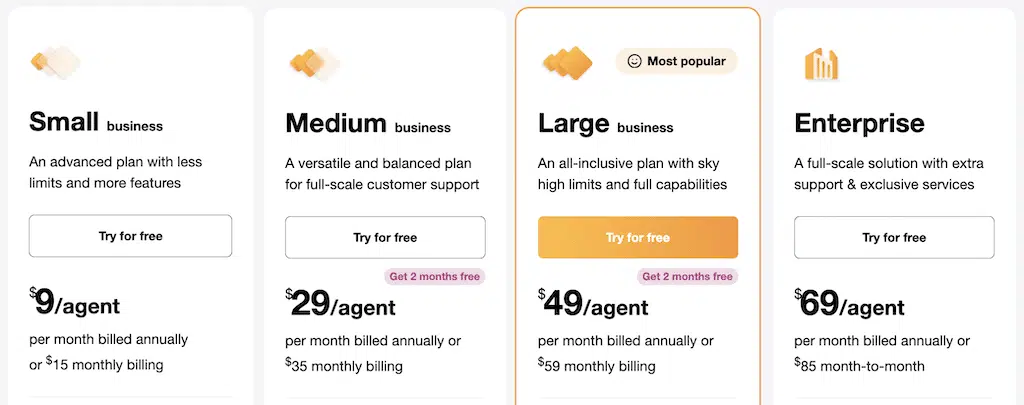

10. Front
Collaborative email platform that combines emails and messages into a single inbox for team collaboration.
Here’s why Front earned its spot on the list:
Front earned its spot on the list because it excels at blending team collaboration with customer communication. Unlike many other tools, it doesn’t just organize messages; it turns them into opportunities for teamwork. With features like shared inboxes and seamless integrations, teams can work together more efficiently without losing the personal touch in customer interactions. It’s designed to streamline workflows while keeping the human element intact, making it stand out in a crowded field of communication platforms.
Front features:
- Omnichannel inbox management
Front makes it effortless to manage conversations across email, chat, SMS, social media, and other platforms—all from one unified inbox. This ensures no customer inquiry slips through the cracks, providing a seamless and consistent support experience. - Real-time collaboration
With Front, teams can work together in real-time on customer responses, assigning tasks, adding comments, and collaborating directly within the platform. This ensures faster resolutions and greater clarity on complex issues. - Call integration
Front integrates with VoIP and other call systems, allowing teams to manage and track customer calls alongside other communication channels. This turns your inbox into a powerful hub for voice and text communication. - Social media support
Respond to customers on platforms like Facebook, Twitter, and LinkedIn without ever leaving Front. By centralizing social media messages, Front simplifies how teams handle social customer service. - Knowledge sharing features
Empower teams to share internal knowledge quickly with shared drafts, templates, and stored responses, making it easy to provide consistent, high-quality answers to customers. - Automation and rules
Front’s robust workflow automation enables teams to automatically assign conversations, escalate issues, and set follow-ups based on customizable rules, reducing manual work and boosting productivity. - Third-party integrations
Front connects seamlessly with tools like Salesforce, Asana, and Slack, allowing teams to manage workflows across different platforms without losing focus. This ensures smooth collaboration and better data management. - Multilingual capabilities
With support for multiple languages, Front enables businesses to deliver personalized customer service to a diverse audience, fostering better relationships worldwide. - Reporting and analytics
Track team performance, customer response times, and overall satisfaction with Front’s detailed analytics and reporting tools. Use actionable insights to continuously refine your support strategies.
Why should you consider Front?
This reviewer genuinely loves Front and finds it an extraordinary tool. They highlight several standout features that make it their go-to platform. First, they appreciate how customizable it is, particularly the shared and private templates, which save time and add value. They also love how Front integrates with tools like Pipedrive, making it easy to find customer information without jumping between systems.
Pros
I like that Front is not just a communication platform, it allows the user to customize the whole experience; the templates are very easy to use, there’s a shared template option but you can also have your private templates which really adds value, also, you can easily find customers from your pipedrive instead of having to look them up separetely.
Another great feature is the option to ‘undo’ a sent email, in case you missed to add something, you can stop the email from being sent to modify it accordingly. It’s my go-to tool, I use it every day even when I’m off work, because I have the app on my phone to make sure I don’t miss anything. So far, I hadn’t had to file any type of ticket for customer support so that speaks volumes.
Things to watch out for:
The reviewer highlights several areas where Front falls short for them. One major frustration is the lack of offline functionality—when they’re on a plane or somewhere without Wi-Fi, they can’t clean up or work on emails, which they find to be a big downside. They also feel that Front could take a page from Outlook by offering more mouse-based functions, like right-clicking to quickly reply or forward emails, instead of requiring so much scrolling and clicking.
Customization is another pain point, as they’d prefer more control over how emails are displayed, such as having emails show up at the bottom of the screen. They also miss simple formatting options like easily adjusting text size or boldness with the mouse and having an “all uppercase” function, which they found very useful in other platforms.
Cons
Well – :
1. If you ie in a plane and have no wifi you can clean up or work on your emails thats a big negative.
2. We mentioned many times to customer support it would be helpful that you were able like in outlook to do more functions with the mouse – like ie. right click and be able to fwd/reply to emails..- in Front is too much scrolling, clicking around – if the mouse will get integrated more huge potential.
3. that you can’t customise the way it looks or you have to read , i prefer ie. have emails to read at the bottom.
4.When you create emails again, it would be helpful if you could change the size/boldness with the mouse. I miss the All Upper Case function very much.
5. Emails need to be written bigger than Outlook otherwise your customer need a magnifying glass to read them
Front Pricing

Other helpdesk software to consider
Here are other help desk software options worth considering, each with its unique specialty:
11. Kayako- Known for its effortless live chat integration and seamless multi-channel support.
12. Intercom- Specializes in customer engagement with proactive messaging and AI chatbots.
13. HubSpot Service Hub- Offers powerful customer service tools integrated with HubSpot’s CRM for streamlined workflows.
14. Freshservice- Tailored for IT teams, focusing on incident management and IT service desk solutions.
15. Groove- Simple and affordable help desk software ideal for small businesses and startups.
16. Tidio- Focuses on live chat and AI-powered chatbots for real-time customer support.
17. HelpCrunch- Combines live chat, email automation, and knowledge base creation in one tool.
18. Drift- Specializes in conversational marketing and sales with a strong focus on live chat.
19. SolarWinds Service Desk- A robust IT service management tool focusing on asset management and incident tracking.
20. Olark- A live chat tool with robust customization and reporting features.
21. Kustomer- A customer service CRM that offers a unified timeline of customer interactions for a personalized experience.
22. SysAid- An IT service management tool with strong asset management and automation capabilities.
23. Talkdesk- A cloud-based contact center platform focusing on voice and AI-driven customer insights.
24. Aircall- Specializes in modern call center solutions with easy integrations and real-time analytics.
25. ManageEngine ServiceDesk Plus- A comprehensive IT help desk solution with advanced automation for ticketing and workflows.
14 key features your helpdesk software should include
To make the process of selecting your helpdesk software simpler we recommend you start by considering the below must-have features in a helpdesk software:
- Unified inbox
- Centralized user-friendly interface
- Omnichannel support
- Security
- Customization option
- Multi language support
- Self-service portal
- SLA’s
- Automation
- Notifications
- Canned responses
- Third party integration
- Knowledge base
- Reporting
1. Unified inbox
A unified inbox serves as an important helpdesk software feature for businesses focused on providing seamless customer support across multiple channels.
This feature offers a centralized platform where numerous agents can efficiently access and manage incoming tickets from various communication channels. By consolidating all customer inquiries into a single location, a unified inbox facilitates collaboration among support teams and ensures a cohesive approach to addressing customer needs.
The primary advantage of a unified inbox lies in its ability to prevent any customer inquiry from slipping through the cracks. By gathering communications from email, chat, web forms, and other channels in one place, businesses can guarantee that no customer inquiry goes unanswered.
This streamlined approach not only improves response times but also enhances overall customer satisfaction by providing timely and consistent support across all channels
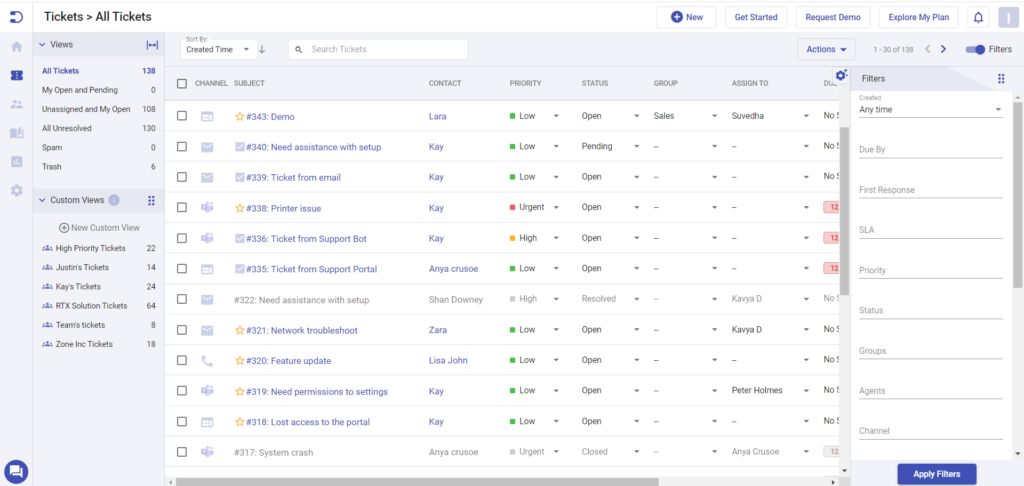
2. Centralized user-friendly interface
A helpdesk software with a centralized and user-friendly interface brings forth numerous benefits for businesses and their support teams.
Firstly, it offers agents a comprehensive view of all support tickets, enabling them to prioritize and manage tasks with efficiency and precision. By consolidating ticket management into one platform, agents can seamlessly navigate through tickets, ensuring no inquiry goes unnoticed or unresolved.
Moreover, the user-friendly interface plays a pivotal role in enhancing the overall user experience by helping users quickly familiarize themselves with the helpdesk software features. This fosters productivity and confidence among agents, enabling them to focus more on providing excellent customer support rather than struggling with complex interfaces.
3. Omnichannel support
Omnichannel support centralizes various support channels within the helpdesk software, enabling businesses to interact with customers seamlessly across multiple platforms. Whether it’s email, phone, chat, web forms, or even web widgets, businesses must be accessible through channels that customers prefer.
By consolidating communication channels, businesses gain visibility into the entire customer journey, regardless of the channel used. This holistic view allows agents to understand each customer’s interactions across different platforms, providing valuable insights into their preferences and behaviors.
4. Security
Data security is of utmost importance for businesses entrusted with sensitive customer information. Prioritizing security features within helpdesk software is essential to instill trust and confidence in customers while mitigating potential risks associated with data breaches or unauthorized access.
Helpdesk software should encompass basic security features to ensure the protection of customer data. This includes measures such as encryption protocols, access controls, and secure authentication methods to safeguard sensitive information from unauthorized access or malicious attacks.
5. Customization option
The key aspect of customization is the ability to add your company’s logo and branding elements to the helpdesk interface. By incorporating your logo and brand colors, you can create a cohesive and branded environment that reinforces your company’s identity and strengthens brand recognition among customers.
Furthermore, customization options extend to contact forms and ticket submission pages, allowing businesses to tailor these components to collect specific information relevant to their support process.
This could include custom ticket fields for capturing additional details about customer inquiries or specific requirements, enabling businesses to gather valuable insights and provide more personalized support.
By leveraging customization options, businesses can interact with customers at a personal level, creating an excellent customer service experience that aligns with their brand identity and values.
6. Multi language support
Amongst the key features, one of the crucial requirements for a helpdesk ticketing system is the ability to support multiple languages effectively. Multi-language support ensures that businesses can provide customer support in the language preferred by their customers, thereby enhancing accessibility and inclusivity. By offering support in multiple languages, businesses can effectively communicate with customers from different regions and cultures, providing good customer service and fostering better understanding and rapport.

When choosing the right helpdesk system, it is imperative to ensure compatibility with multiple languages to meet the diverse needs of customers. This includes features such as multilingual interfaces, translation capabilities, and support for language-specific content, ensuring seamless communication and support interactions across language barriers.
Read more: Changing the language in Desk365 Support Bot
7. Self-service portal
A self-service portal stands as an asset for businesses aiming to enhance customer support efficiency and satisfaction. This feature empowers customers by providing them with the tools and resources to independently find information and resolve issues. A self-service portal typically offers:
- Interactive FAQ section where customers can find answers to commonly asked questions. This section is accessible both within the helpdesk platform and to customers directly.
- Knowledge base articles where customers can access a repository of knowledge base articles aimed at educating and guiding them on various topics. These articles cover a wide range of subjects and are designed to provide comprehensive information to users.
- Information classification: where information is organized and classified according to subjects within the self-service portal, making it easier for customers to locate relevant resources quickly.
By offering self-service options, businesses can reduce the volume of incoming support inquiries, allowing agents in the customer service team to focus on more complex issues and improve overall efficiency.
8. SLA's
Service Level Agreements (SLAs) are another important component, enabling companies to establish clear standards and deadlines for ticket resolution based on priority levels. SLAs ensure that support teams prioritize and address customer inquiries promptly and effectively, thereby enhancing overall customer satisfaction.
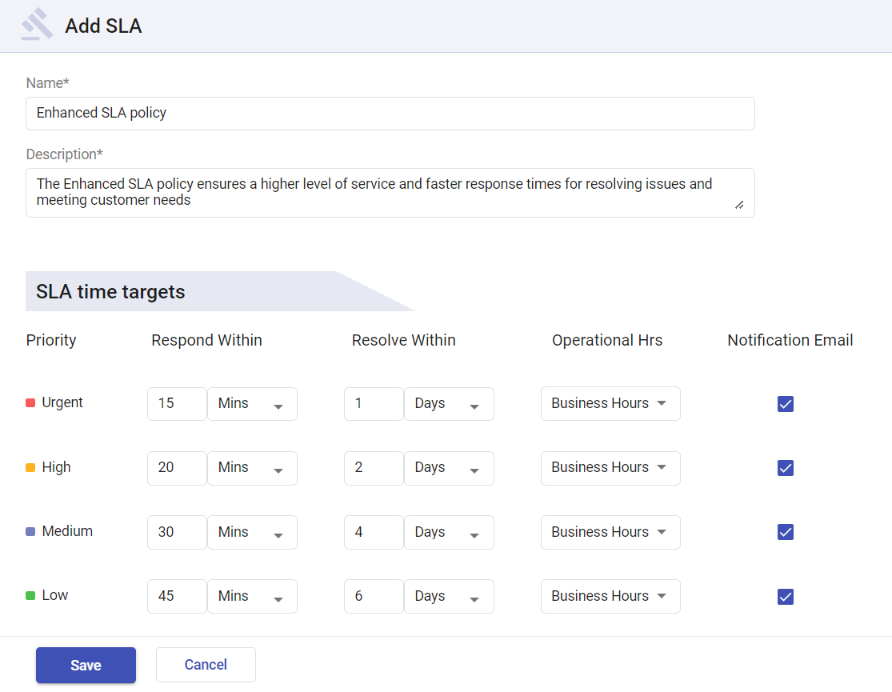
With helpdesk software, businesses can define their own SLA policies, specifying response and resolution times for different types of tickets based on their urgency and importance. By setting these standards, companies can ensure that support requests are handled in a timely manner, meeting or exceeding customer expectation.
Read more: Configure SLAs and apply them to tickets
9. Automation
By leveraging automation capabilities, businesses can optimize efficiency, reduce manual workloads for agents, make ticket handling easy, and deliver faster and more seamless support experiences to customers.
One of the key benefits of automation is its ability to streamline repetitive tasks such as ticket routing and categorization. The helpdesk system can automatically assign incoming tickets to the appropriate agents or departments based on predefined criteria, ensuring that inquiries are routed to the most qualified individuals for resolution.
By harnessing the power of automation, businesses can streamline their operations, save time and also minimize the risk of tickets being overlooked or mismanaged.
Read more: Configuring automation rules
10. Notifications
Amongst, the helpdesk features notifications play a crucial role in keeping both agents and end-users informed of new tickets, changes in ticket status, and other relevant updates, notifications ensure timely responses and facilitate seamless communication between all parties involved.
For agents, notifications provide real-time updates about new tickets assigned to them, changes in ticket status, and any other relevant information that requires their attention. This allows agents to prioritize their tasks effectively and respond promptly to customer inquiries, thereby enhancing overall support efficiency
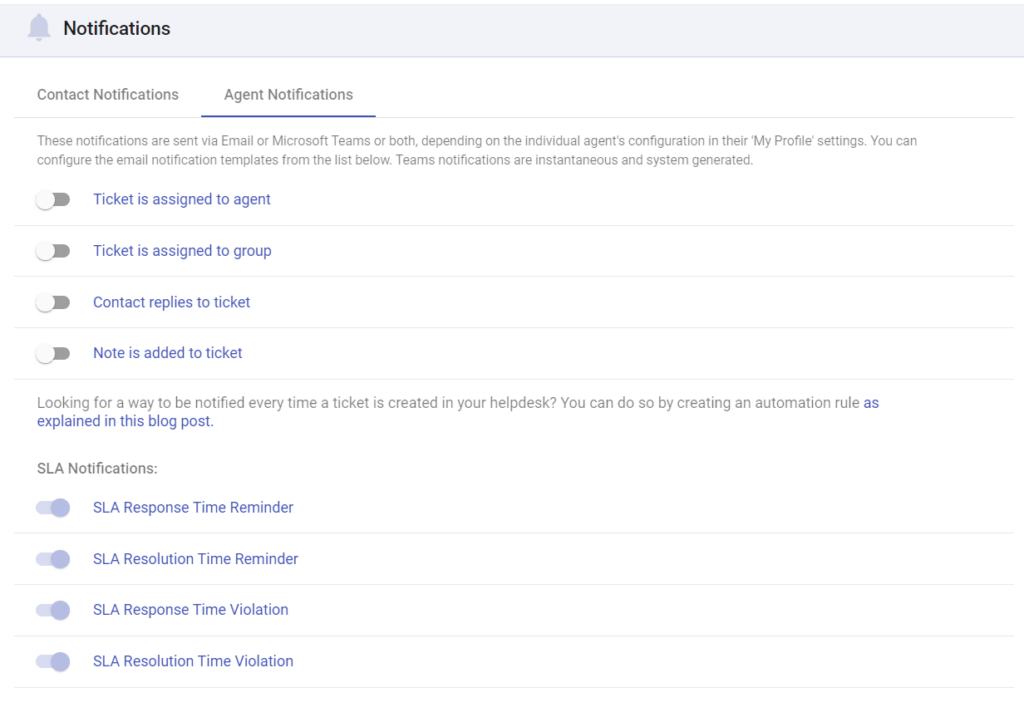
Similarly, end-users receive notifications about the progress of their tickets, ensuring transparency and keeping them informed about any updates or resolutions. This proactive communication fosters trust and confidence in the support process, ultimately leading to improved customer satisfaction.
Read more: How to Configure Notification Channels in Desk365?
11. Canned responses
Canned responses serve as a valuable tool to help agents manage this workload more efficiently. These pre-written responses allow agents to quickly respond to common or repetitive queries without the need to manually craft each response from scratch.
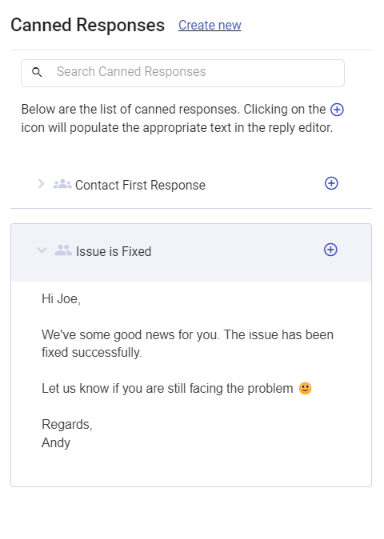
They are particularly useful for addressing frequently asked questions or handling standardized inquiries. By saving commonly used responses in a centralized database, agents can easily access and deploy them whenever needed, saving valuable time and effort.
Read more: Setting up Canned Responses
12. Third party integration
This feature allows seamless integration with various external tools and applications, enabling businesses to streamline their workflows and optimize efficiency.
By integrating with third-party tools, businesses can unlock additional functionalities and features that may not be available natively within the helpdesk software. This flexibility allows organizations to tailor their support processes to meet their specific requirements and adapt to evolving business needs.
Read more: Desk365’s integrations
13. Knowledge base
A knowledge base is an essential feature of any quality helpdesk. It serves as a centralized repository of information, enabling businesses to effectively manage and share knowledge both internally with agents and externally with customers for self-service.
Internally, the knowledge base provides support agents with easy access to a wealth of information, including user guides, troubleshooting tips, best practices, and more. Externally, the knowledge base serves as a valuable self-service tool for customers, allowing them to find answers to their questions and resolve issues on their own. A well-maintained knowledge base improves support efficiency, enhances customer satisfaction, and promotes self-service.
Read more: Setting up knowledge base articles
14. Reporting
The reporting feature offers a wealth of insights into various aspects of support performance, empowering businesses to make data-driven decisions.
One of the primary benefits of reporting features is their ability to analyze agent performance. By tracking metrics such as response times, resolution rates, and customer satisfaction scores, businesses can identify top-performing agents and areas where improvement is needed. This insight enables managers to provide targeted training and support, ultimately enhancing overall team performance.
Additionally, reporting features allow businesses to monitor ticket volume and trends over time. By analyzing ticket influxes, businesses can anticipate peak periods and allocate resources accordingly, ensuring timely responses to customer inquiries. Moreover, identifying trends in support requests enables businesses to proactively address common issues and implement preventive measures to minimize future occurrences.
Read more: Reports & Analytics
Selection criteria for helpdesk software
When selecting help desk software, it’s crucial to go beyond the usual checklist of features and look for nuanced factors that can transform the way your team operates. Here are some fresh, overlooked perspectives to consider while evaluating help desk tools:
1. Does it handle real-life complexity?
Many help desk tools promise streamlined operations but fail when faced with real-life complexity. Look for software that can manage:
- If your agents handle multiple tickets or chat sessions at the same time, the system should have features like smart alerts to avoid dropped interactions.
- Real-world tickets often depend on the resolution of other issues (e.g., a product bug that’s affecting customer tickets). A help desk should let you link related tickets so progress in one is visible across all.
2. Can it scale intelligently?
Scaling isn’t just about adding users—it’s about maintaining performance and efficiency as your workload grows. Evaluate:
- Does the system’s performance remain smooth during seasonal peaks or sudden surges in ticket volume? Tools built on scalable cloud infrastructures are better equipped for this.
- Can the tool handle your growing customer base without slowing down reporting, search, or analytics? Look for systems that offer fast data queries even as ticket numbers grow.
3. How well does it adapt to non-traditional use cases?
Help desks aren’t just for customer support anymore—they’re used for internal IT support, HR requests, and more. Check if the tool can:
- For instance, routing IT tickets to technicians while HR inquiries go to the people team—all within one system.
- Tickets often require input from multiple teams. Does the system facilitate smooth collaboration between departments like product, legal, or marketing?
4. Accessibility for distributed or remote teams
As remote work becomes the norm, help desk software should cater to distributed teams. Look for:
- The system should allow tickets to be assigned or prioritized based on time zones, ensuring that SLAs are met for global teams.
- For agents in remote locations, tools with lightweight versions or offline capabilities are invaluable.
5. Data security and compliance
With growing concerns over data privacy, it’s no longer enough for tools to “offer security.” Assess:
- Can you restrict sensitive data access based on roles (e.g., financial information visible only to certain agents)?
- Beyond general compliance (like GDPR), does the software allow industry-specific customizations (e.g., HIPAA for healthcare or CCPA for California-based customers)?
Emerging trends in helpdesk software for 2025
As we approach 2025, helpdesk software is set to undergo significant transformations, driven by technological advancements and evolving business needs. Key emerging trends include:
AI-driven customer support becomes the norm
AI will enhance help desks with smarter chatbots, predictive ticketing, and real-time agent assistance. By 2025, systems will proactively resolve issues, assist agents with suggestions, and reduce response times, creating a seamless and personalized support experience.
Hyper-personalization
Help desks will deliver tailored experiences with sentiment tracking, unified customer profiles, and dynamic SLAs. By leveraging behavior and interaction data, they’ll ensure every customer feels valued and understood.
Omnichannel evolution with emerging platforms
Support will extend to platforms like TikTok, WhatsApp, and IoT devices. Customers will seamlessly switch between channels while businesses maintain unified communication, offering convenience and consistency.
Deeper automation in workflows
Automation will handle complex workflows like event-triggered ticket creation, workload balancing, and quality checks. This will streamline operations, allowing teams to focus on high-value tasks.
Focus on agent experience and well-being
Help desks will prioritize agent health with workload monitoring, gamification, and stress detection. Tools will encourage balanced workloads and celebrate achievements to keep agents motivated and engaged.
Helpdesk software based on organization size
When choosing helpdesk software, the organization’s size plays a crucial role in determining the right solution. Here’s an overview of helpdesk software options tailored to small, medium, and large businesses:
1. Small teams or startups
Features:
- Basic ticket management
- Email and chat support
- Limited automation
- Basic analytics and reporting
Tools:
- Freshdesk Free Plan
- Zoho Desk Standard
- HubSpot Service Hub Starter
2. Growing SMEs (Small to Medium Enterprises)
Features:
- Multichannel support (email, chat, phone, social media)
- Collaboration tools
- Customizable workflows and automation
- Moderate integrations (CRM, analytics tools)
- SLA management and escalation features
Tools:
- Desk365
- Zendesk Team
- Freshdesk Growth
- Zoho Desk Professional
3. Large enterprises
Features:
- Advanced analytics and reporting
- AI and chatbots for automation
- Omnichannel support
- Enterprise-level security and compliance (GDPR, HIPAA)
- Extensive integrations (ERP, advanced CRMs, workforce management tools)
- 24/7 support and custom SLAs
Tools:
- ServiceNow
- Salesforce Service Cloud
- Zendesk Enterprise
No matter your business size—whether you’re a budding startup, a thriving SME, or a large-scale enterprise—Desk365 is built to adapt and grow with you. It strikes the perfect balance between simplicity, scalability, and affordability, offering features tailored to your specific needs. From basic tools to manage customer queries to advanced solutions for optimizing large-scale operations, Desk365 is here to help you succeed.








